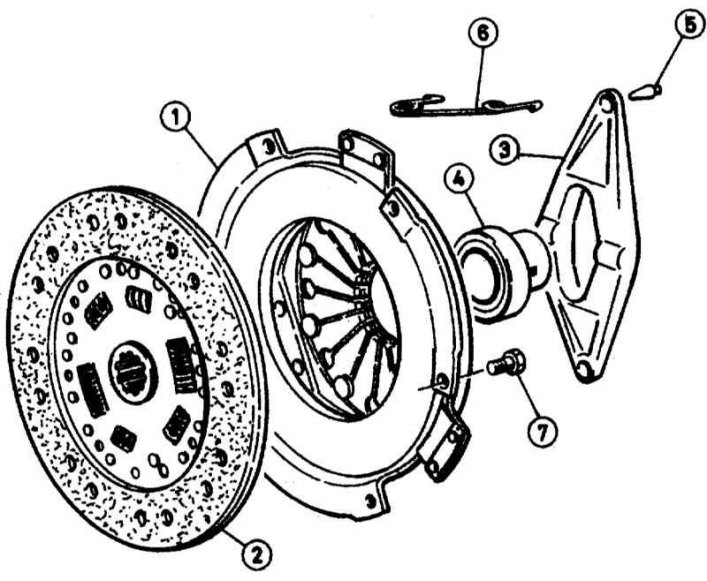Typical Clutch Assembly Components

1 - Pressure plate
2 - Clutch disc
3 — the Lever of inclusion
4 - Release bearing
5 — a finger with a spherical tip
6 — Lever fixing spring
7 - Bolt
The clutch is actuated by a hydraulic system.
When depressing the clutch pedal, the hydraulic fluid (pressure generated by the clutch master cylinder) transmits power to the slave cylinder. Since the slave cylinder is connected to the clutch release fork, this fork brings the release bearing into contact with the pressure plate petals, disengaging the clutch disc.
The hydraulic system adjusts the clutch automatically, so no further actuator or pedal adjustment is required unless you have replaced the clutch master cylinder and/or pushrod.
In the process of working with instructions, sometimes there may be problems with terminology related to clutch components, because. different manufacturers, dealers in auto parts stores, and car dealers call the same parts differently. For example, the driven disk is also called the clutch disk and the friction disk; the slave cylinder is sometimes called the slave cylinder, etc.
Examination
Components with obvious damage should be replaced, but for cases where the cause of system failure is not so obvious, here are a few preliminary diagnostic checks.
1. The first step is to check the fluid level in the clutch master cylinder. If it is low, top up and check clutch operation again. If you have drained the master cylinder or serviced any of the components in the hydraulic system, bleed the system (see Section Bleeding the hydraulic clutch system). If you have to top up too often, then this is probably due to fluid leakage.
2. To check the clutch disengagement time, start the engine and let it run at normal idle with the transmission in neutral (clutch pedal up). Disengage the clutch (pedal down), wait a few seconds, then engage reverse gear. In this case, a rattle should not be heard. The rattle indicates a failure of one of the components, probably in the pressure plate or driven plate assembly.
3. To check the completeness of the clutch disengagement, start the engine (apply the brake so that the car does not move) and hold the clutch pedal approximately 1-2 cm above the floor. Switch the box several times from the first gear position to reverse and vice versa. If the switching is not smooth, then one of the components is faulty.
4. Inspect the clutch pedal bushing at the top of the pedal to make sure it is not worn or obstructing pedal travel.
